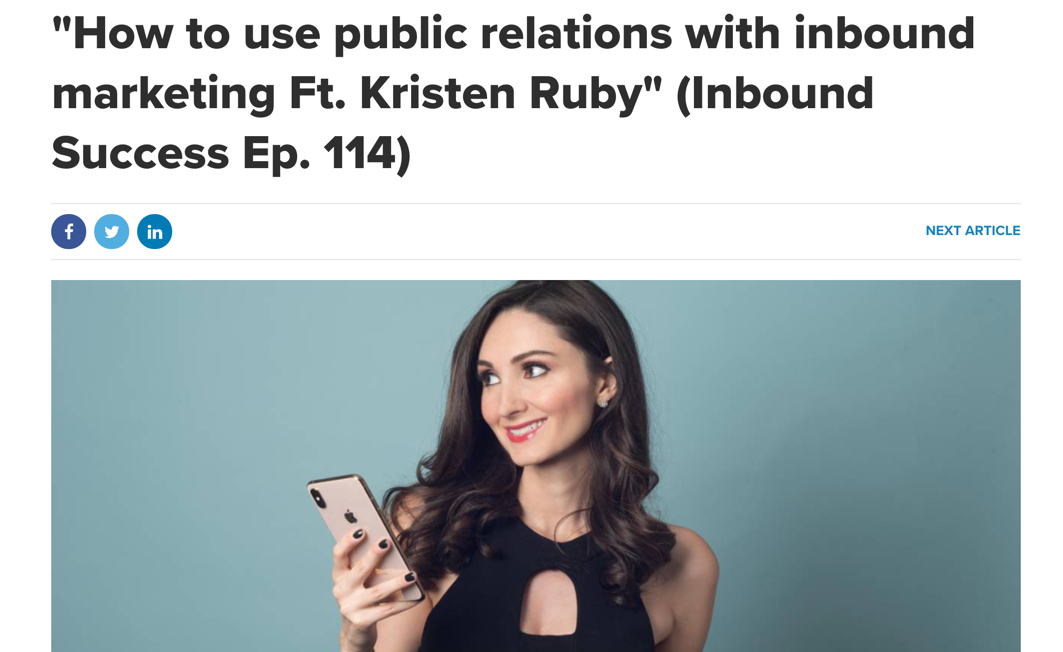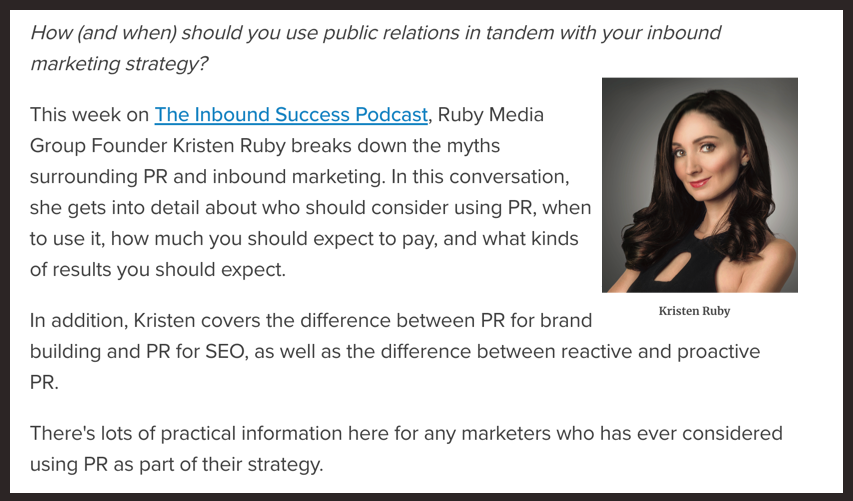
INBOUND PR
Inbound PR increases backlinks to your web site and increases visibility.
If you already work with a PR firm or are considering launching a media campaign for your business or medical practice, then you have probably heard of inbound marketing.
But, what is inbound marketing and how can it help your business?
First, let’s start with what inbound marketing is and next we will share with you why PR and inbound marketing must work together for your public relations campaign.
What is inbound marketing?
Inbound marketing focuses on empowering your potential customers by giving them the information they need to help find your business online. Your goal should be to create content that will help solve your prospect’s problem.
When you made your last purchase, did you call a salesperson asking to buy or did you hop online and conduct thorough research? Chances are, you conducted thorough research, but when you did that research you didn’t type in a company’s name (because you don’t know the name yet). Instead, you Googled the problem you had.
When your prospect searches for their problem, your company needs to be on page 1 of Google so the buyer sees you as a solution to their problem.
INBOUND MARKETING AND PUBLIC RELATIONS
Why does inbound marketing matter for PR executives?
Inbound marketing is important for digital PR practitioners because every company and brand needs a digital footprint to build trust and authority. Today, all medical practices need a content library and inbound newsroom to attract more media attention and build buzz with members of the press. Even repurposing old press releases and turning the content into blog posts can help secure backlinks and increase your organic SEO.
A synonymous title for digital PR could actually be earning inbound links! Your PR firm is instrumental in your inbound marketing efforts.
Tip: Imagine yourself as a potential customer of your business. Go to Google and search for the problem as if you were your customer. Does your company show up on the first page at the top in organic search results? If not, keep reading!
Positioning your business at the top of Google is one of the main goals of inbound PR.
Publicists can help craft inbound content and backlinks that can drive traffic to your site and help you get found by your prospects.
There are three main ways to get found online:
- Organic search results
- Paid advertising
- Press
Inbound PR works with content marketing and PR to achieve the primary goal of helping you get found in editorial outlets and increasing organic search results. So, how do you get started with inbound marketing, and how can you translate your key findings to a PR campaign?
How do you get started with inbound marketing?
Create your buyer persona.
Your job is to deliver information that prospects need to help them make smart, informed purchase decisions. When thinking about the motives of buyer personas, focus on the ‘why.’ Uncovering their motives can lead to a powerful content marketing strategy. To create your buyer persona, ask the following questions:
- Who is your ideal customer?
- What information is most valuable to your prospects?
- How do they like to consume information?
Once you have determined who your buyer persona is, you can then focus on creating keyword-rich content to reach them.
Now that you have a good understanding of what your prospects are looking for, you can either create content around these search terms or you can use the search terms in your public relations campaign when you conduct interviews with the media.
Tip: Try interviewing current clients and look for trends in their responses. It’s your job to know what they want to see, what they want to read, and what issues they are currently dealing with. If you are still wondering, “How can I engage my current customer base more?” you can always ask current clients these questions. Their answers can prove to be invaluable in your market research.

“Put the education of your prospect before your personal initiatives.” – Hubspot
INBOUND MARKETING STRATEGIES
How do you write an inbound marketing plan?
Content Creation
With inbound marketing, your customers don’t want to be sold to. They want to be educated.
It is your job to talk them from the decision stage to a solution strategy. Your content should focus on a methodical approach that helps readers learn more about your company. Ideally, after reading your valuable content over time, they will think about your company when thinking about who to buy products and services from in your niche because you have provided so much value. Be sure you have content prepared for every part of your buyer’s journey.
Tip: When it comes to inbound marketing strategies, your job is to make it easy for current customers and potential buyers to find and consume your content.
Formatting Content
What format will you use? Is your persona a visual learner? Do they read blogs on a regular basis? Do you have a valuable piece of content that belongs behind a form vs. on your blog? Here are some options that were recommended in the certification program for creating content:
- Case studies
- Videos
- Infographics
- White papers
- Worksheets
- Ebooks
- Templates
- Checklists
- Webinars
- Slideshare decks

“Use content as your currency and create content that your prospects are looking for.” – Hubspot
Awareness, Consideration, Decision
After a prospect is aware of their problem, they are in the consideration stage and are committed to understanding all available methods to solving the problem. You want to make sure you reach your prospect in the consideration stage by creating keyword-rich content.
Remember, consumers don’t want to be sold to; they want to be educated.
Once they are in the decision stage and have decided on a solution strategy, they are focused on the method of approach. It is important to have content prepared for each stage of the buyer’s journey. This is also why Inbound PR is so critical, because one area buyers want to get information from is through media interviews and trusted outlets. Your inbound marketing strategy is not complete if it does not leverage earned media and public relations strategies.
Keywords
Keyword research is critical to giving a name to your prospect’s problem.
Remember, think about the phrases that prospects are using to find someone who offers your services, instead of thinking about what search terms you would use. Try not to use too much industry jargon either.
Categorize keywords: Do this by stages of the buyer’s journey.
Keywords should include: problem-based keywords, solution keywords, branded keywords, and casual language. Use keywods.io or Google’s webmaster tool to get suggestions.
CTA (Call to Action)
Every blog post in your inbound marketing strategy should also have a call-to-action or CTA.
Examples of calls to action include:
- Download
- Request
- Sign up here
Pro Tip: When writing your CTA, focus on action verbs.
Content Creation Tips
Understand their problem: In order to provide a solution to potential customers, you need to first recognize the problem. Is your content focused on their problem?
Tailor the post: Write blog posts tailored to who you are trying to reach and what they are interested in. The best content has to be grounded in the correct context to meet the searchers intent.
Question the post: After you write content, determine if the content helps your buyer persona. If your answer is that it helps anyone other than your target buyer persona, it belongs somewhere else on your site or it shouldn’t be created. Always focus on mapping content to your persona and where they are at in the buyers’ journey. Make it easy for them to consume your content.
Another trick: If you are stuck creating content, ask:
- What questions might buyer X have that your company could provide solutions to?
- Does this content help my ideal buyer persona(s)?
Your content should always focus on mapping content to your persona and where they are at in the buyers’ journey.
Distribute content: Make your content available through other platforms so prospects can find it more easily. It’s not enough to just have content; you also need others to redistribute it. Examples of inbound PR distribution platforms include social media channels, podcasts and guest posts.
Leverage the sales team for content ideas: What questions do people have who are interested in what you do? Work with your sales team to leverage prospects’ questions into great content! Figure out what your prospects are searching for so you can make sure they find your site. Make sure you are addressing a topic your prospects actually want to learn about.
SEO Tips for Optimizing Your Inbound Marketing Campaign
To optimize your content, you need to be specific with your service offerings to improve your chance of ranking. You have a greater likelihood of ranking on search engines if your keywords are more specific and targeted.
If you are looking to boost your SEO, follow these tips:
- Set up business listings on the top online directories including Yelp, Yellow Pages, local chambers of commerce, Bing, Yahoo and more.
- Create content that uses natural language and variations on the long tail keywords.
- Shorten blog or content titles to under 60 characters.
- Headlines more than 60 characters long will get cut off in search results page.
- White space is your friend. Focus on content, not clutter.
- Use section headers, bullets and lists to help break down the content.
- Optimize the page around long tail keywords, including your page title, URL, post title, image alt text, body and headers.
Measuring Success
It’s important to measure the success of your inbound marketing content strategy. Focus on the following metrics and start a monthly content measurement report:
- Number of page views and visits per blog or other content posting including time spent
- Leads generated from specific blogs/content posts
- Social media share numbers
- Inbound link generation analytics
Tip: Here’s a trick to see if your current blog posts are hitting your buyer persona(s). Search Google for the last five blog posts your company has created. Now search for five of your most ideal clients online (go to their websites and poke around). Do you think these types of clients would actually take the time to sit and read these five blog posts from your company?
Are you really providing solutions or just repeating the same old brand stories? Put the education of your prospect first.
Inbound Marketing Mistakes
Avoid these inbound marketing mistakes that can derail the success of your campaign.
- The buyers journey has to be from the buyers’ perspective, not yours.
- Your content needs to answer their problems vs. going straight to your business solution.
- Your blog shouldn’t discuss your specific solution until buyer has reached the decision stage.
Remember, your content is a solution to your prospect’s greatest challenges. Make sure you use keywords that will draw attention to your patients and clients by crafting a stellar content marketing strategy.
I recently completed the Hubspot Inbound Marketing Certification program. There were some great takeaways that I wanted to share with you to help increase your brand exposure. If you need a quick refresher on best practices for digital PR, this is a perfect guide. If you want to get inbound certified, click here.
INBOUND PR AGENCY
PR and Inbound Marketing must work together to guarantee success. However, many traditional PR firms are not trained in Inbound PR methodologies. Ruby Media Group is Hubspot Inbound Certified and we constantly stay current on the latest inbound practices. We specialize in inbound marketing for doctors and healthcare inbound marketing strategies. If you are interested in leveraging an inbound PR strategy for your practice, contact us today for a consultation.
Ruby Media Group is a premiere public relations firm in Westchester County. For more information on optimizing your exposure, contact kruby @ rubymediagroup.com
RESOURCES
INBOUND SUCCESS PODCAST: How to use Public Relations with Inbound Marketing
*Date last updated 2019

KRIS RUBY is the CEO of Ruby Media Group, an award-winning public relations and media relations agency in Westchester County, New York. Kris Ruby has more than 15 years of experience in the Media industry. She is a sought-after media relations strategist, content creator and public relations consultant. Kris Ruby is also a national television commentator and political pundit and she has appeared on national TV programs over 200 times covering big tech bias, politics and social media. She is a trusted media source and frequent on-air commentator on social media, tech trends and crisis communications and frequently speaks on FOX News and other TV networks. She has been featured as a published author in OBSERVER, ADWEEK, and countless other industry publications. Her research on brand activism and cancel culture is widely distributed and referenced. She graduated from Boston University’s College of Communication with a major in public relations and is a founding member of The Young Entrepreneurs Council. She is also the host of The Kris Ruby Podcast Show, a show focusing on the politics of big tech and the social media industry. Kris is focused on PR for SEO and leveraging content marketing strategies to help clients get the most out of their media coverage.
